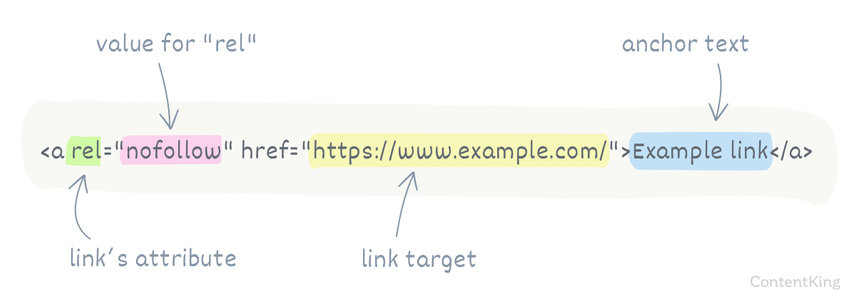Nofollow link and rel=nofollow explained
The nofollow link attribute was introduced in 2005 by Google to deal with spammy links that were being used to game the system. Currently, Google treats the nofollow link attribute as a hint rather than a directive.
To better distinguish among the origins of non-natural links, Google has recently introduced two other attribute values that complement the nofollow link attribute:
- rel="sponsored" to mark paid and sponsored links
- rel="ugc" to mark user-generated content links in forums, comments and message boards
In general, the nofollow link attribute should be used for unnatural links and when the website owner doesn’t want to be associated with the link’s target URL.
What is the nofollow link attribute?
The nofollow link attribute refers to links that have the “nofollow” value in their rel attribute. The rel attribute is used to provide context about the relation of the linking page with the link target.
The nofollow value for the rel link attribute is used to signal to search engines that they shouldn’t follow these links and therefore shouldn’t pass any link authority to the link target. Google in particular may, however, choose to ignore this and follow the link and/or pass on link authority.
Correct terminology
99% of the time, incorrect terminology is used to describe links with the nofollow value in their rel attribute. We’ve seen it all: “nofollow tag”, “nofollow attribute,” and “nofollow link attribute”.
Even though it’s still technically incorrect, we’ll use “the nofollow link attribute” throughout this document for the sake of simplicity and because it’s as close as it gets to using the right terminology.
Here’s an example of the nofollow link attribute in action, and a breakdown:

Why did we start needing the nofollow link attribute?
The concept of the nofollow link attribute dates back to 2005 , when Google was trying to tackle an unbearable influx of spammy links through blog comments, message boards, and forums.
As these links were helping low-quality websites rank higher than much more high-quality websites, Google introduced the nofollow link attribute to try and filter the bad ones out. Through the nofollow link attribute, Google learns about a link’s context, and they use this in their efforts to make ranking more fair.
When should you use the nofollow link attribute?
The nofollow link attribute should be used when a link hasn’t occurred naturally or isn’t being earned via genuine interest.
In general, you should use the nofollow link attribute for example for:
- Cases where you need to link, but don’t want to be associated with the link target
- Widgets
- Certification badges
- Press releases
What Google says about nofollow links
As we mentioned in our article about Google’s big nofollow announcement , the search engineSearch Engine
A search engine is a website through which users can search internet content.
Learn more has recently changed its policy towards nofollow attributes. From March 1, 2020 onwards , Google doesn’t recognize the nofollow link attribute as a directive anymore, but instead, they now treat it as a mere hint.
It’s likely that most nofollow links still won’t benefit your rankingsRankings
Rankings in SEO refers to a website’s position in the search engine results page.
Learn more, but Google can potentially choose to ignore the nofollow link attribute and use the links for ranking purposes as well.
Other values: ugc and sponsored
Alongside this policy change, the search engine has come up with two new attribute values to mark a link’s specific use—the rel="sponsored" and rel="ugc" values.
Google wants these new attribute values to replace the use of the nofollow link attribute in certain cases and thus express the true origin of links. Currently, the search engine suggests that the “sponsored” value be used for all forms of advertisements or paid placement, and “ugc” for user-generated content (UGC) links, such as comments and forum posts.
The nofollow link attribute can still be used in all these cases, but according to its guidelines, Google prefers the two new types instead because they convey more context.
As for the nofollow link attribute, Google now suggests you use it for links which are neither sponsored nor user-generated but which still need a signal that you don’t want to be associated with the linked website, or that you don’t want Googlebot to crawl the linked pages.
When Google's 2019 Webspam report came out, the SEO community was surprised to read the following:
We introduced two new link attributes,
rel="sponsored"andrel="ugc", that provide webmasters with additional ways to identify to Google Search the nature of particular links. Along withrel="nofollow", we began treating these as hints for us to incorporate for ranking purposes.
So apparently, all three link attribute values are now being used for ranking purposes. Kudos to AJ Kohn for discovering this . Pro-tip: follow AJ on Twitter, you'll learn something — we promise :)
Google suggested that they will "generally" treat links with these new values the way they treated nofollowed links: by not including them in their ranking evaluations. In the same article, Google later says that the new link attributes are hints that they can incorporate for ranking purposes. This statement has been confusing for many SEOs who are wondering whether to use
rel="sponsored"orrel="ugc".The main takeaway here is that Google can choose to use these link attributes for ranking purposes if it wishes to, specifically when it comes to evaluating the link containing the attribute, although they are not explicitly telling us whether they will or how. That said, Google has confirmed that the presence of these link attributes on the page will not be used as a ranking factor to evaluate the webpage or the website using the attributes. Therefore, their use is entirely optional and won't serve to benefit your SEO strategy - at least for now.
There’s plenty of misconceptions about how attribute values should be used on internal and outbound links, and it’s easy to get perplexed by the effect of an attribute particularly now that they’re recognised as “hints”.
Though, the rule is really quite simple: if you’ve got existing "nofollow" links that are obviously user-generated or sponsored content, and can easily be updated to "ugc" or "sponsored", I’d go for it. Otherwise, I’d leave them as is and only use the more specific link attributes on new links. I would also always assume Google won't follow an outbound link with any of the previously mentioned link attributes, and that no benefit is ever going to be passed to the linked party. I'd assume that it's the opposite for an internal link but usually there's better ways to tell Google not to follow an internal link anyway, for example using your robots.txt.
Combining the nofollow link attribute with other values
Google lets you use the new attributes in combination with the nofollow tag. For instance, you can use both “sponsored” and “nofollow” for paid links. You can use a space to separate the values, or a comma—either is fine.
Here are two examples which are both valid
<a href="https://example.com/" rel="nofollow sponsored">Anchor text</a>
<a href="https://example.com" rel="nofollow,sponsored">Anchor text</a>
How to avoid the unnatural outbound penalty
Having low-quality or other violative external links on your page be followed can lead to a sanction that Google calls the “unnatural outbound links penalty”. This penalty occurs when the search engine finds “a pattern of links on your website that is either unnatural or irrelevant”.
Follow these policies to avoid the unnatural outbound penalty:
- Avoid linking to low-quality websites and spam
- Use
nofolloworugcon all user-generated content by default - Review the links in any guest posts
Other uses of the nofollow link attribute
Although the nofollow link attribute is mostly used for outbound links, there are situations where it could help you with your internal structure too.
For instance, the nofollow link attribute can prevent search engines from following links to filtered product pages. The use of filters—and faceted navigation in particular—can generate an enormous amount of URLs with near-duplicate contentDuplicate Content
Duplicate content refers to several websites with the same or very similar content.
Learn more. Applying the nofollow value to the links used on filter parameters is one way to prevent unnecessary crawling of these URLs.
In the example below, we are instructing search engines not to follow our color filter for socks. While the socks category of the website remains indexed, the nofollow link attribute prevents the search engine from crawling the filtered website that might have thousands of nearly identical variations.
<a href="https://example.com/socks/?color=black" rel="nofollow">Black</a>
However, this approach isn’t fool-proof and never was — if someone links to those filtered pages from a different website, search engines can still follow those links and crawl the filtered product pages.
And besides, Google's now treating the nofollow link attribute as a hint rather than a directive.
If having your filtered product pages crawled is a relevant risk, it’s best to use disallow directives in your robots.txt file.
Link sculpting with nofollow is so 2010
About 10 years ago, adding the nofollow link attribute would result in no link authority being distributed to those linked pages, and instead, other linked pages with regular followed links would get more link authority.
For example, you have 8 links on a page, and normally each link would transfer 1/8 of the link authority. If you nofollowed 4 of the links, the 4 followed links would each get 1/4 of the link authority instead of 1/4 of the authority. This practice is called link sculpting.
However, this approach hasn’t been working for over a decade. Google will treat the authority that would normally be passed on when linking without nofollow as lost. Therefore, in this case, this would cause 1/2 of the link authority to vanish. In other words, attempting link sculpting like this is more harmful than beneficial.
With Google advising internal nofollow links draw pagerank away from the remaining internal links on the page, SEOs have had to look towards other methods to attempt PR sculpting. Some of the popular methods for obfuscating links are by using scroll event, using onclick events and intentionally malforming the links to prevent discovery by Google. Martin Splitt mentioned a couple of examples of what not to do if you want Google to find a link, which translates into ideas to consider when trying to hide them. Caveat: this can also impact accessibility, so you might unknowingly create user issues by trying some of these tactics.
Do nofollow links benefit your SEO performance?
The nofollow link attribute was designed to battle link spam, and Google is now using the attribute as a hint rather than a directive. This begs the question: "do nofollow links now benefit your SEO performance?"
Yes, they do. Both directly, and indirectly.
The direct benefit
In the cases where Google ignores the nofollow link attribute, the link will benefit your SEO performance. Link authority aside, we’ve always been of the opinion that nofollowed links from strong domains can still be used as a sign of authority. Take for example links from strictly curated Wikipedia pages.
The indirect benefit
And then there’s the indirect effect (which has always been there). If we take the Wikipedia example again, you’ll find that a lot of people use Wikipedia sources as references for their own content, meaning that it’s likely they’ll link to you as well. Not to mention, many people copy sections (or entire pages) from Wikipedia and keep the links untouched.
Would you turn down a link from the New York times just because it was nofollow? I doubt it…
In recent years, we've seen many top-tier publishers take the decision to apply a blanket nofollow policy to all external links, which led to Google losing large parts of the link graph. And let's not forget that the newer version of PageRank may be using a set of trusted pages that act as seed sites.
Quite simply, my belief is that there was a need to treat
rel="nofollow"as a hint rather than a directive to open back up the link graph, especially around these seed sites.A quality earned link is a trust and authority signal, even when this is nofollow, as far as I'm concerned. And I've seen numerous examples of top-tier links having a positive impact upon organic visibility, even when a noticeable percentage of these are nofollowed. I often see what I call the "snowball effect": when additional publications cover a story because they first saw it on another publication. Even if the original coverage includes a nofollow link, the links earned from snowball coverage are often followed.
One of the ways that I always analyze a potential link opportunity is by asking myself (or my client) whether we'd still want that link if Google didn't exist. This immediately gets you thinking about the benefits of great links outside of SEO; with the main one of these being relevant referral traffic from who could become your next client or customer.
Look beyond rankings
Don’t forget: nofollow links can still generate traffic — that’s the whole idea of linking. At the end of the day, is what you’re after: visitors who are likely to convert. They may come through Google Search, but they may also end up on your site through a link on a highly relevant page on someone else's website.
Editorially placed links are increasingly nofollowed but, as we have no control over most of the coverage, fighting to change the link type is rarely successful. When a campaign has a large amount of coverage, we do still see a range of link types coming to the site, but we need to look beyond links for just their SEO value.
A highly relevant link in the right place, followed or nofollow, can bring engaged visitors to your site, and increase your audience and brand reach, which can be just as valuable as link strength.
Dofollow vs. nofollow links
When people are talking about links, and they want to explicitly denote links that aren’t nofollowed, they’ll often use the term “dofollow” links. However, there’s no such thing as a “dofollow link”. It’s a made up term, not a value for the link attribute. The correct terminology would be to just call these links “followed links”.
<a href="https://example.com" rel="nofollow">Some anchor text</a>
Here’s a regular link:
<a href="https://example.com">Some anchor text</a>
And the code example below simply isn’t correct. Search engines are likely to just ignore the value and treat it as a regular link.
<a href="https://example.com" rel="dofollow">Some anchor text</a>
Nofollow link attribute vs. meta robots nofollow
When we’re speaking of the nofollow link attribute, we shouldn’t pass over something that sounds similar but has far more severe consequences—the meta robots nofollow directive.
While the nofollow link attribute is used for a particular link only and doesn’t affect other links on the page, the meta robots nofollow directive is defined on the page level, meaning that including it in the page source applies the nofollow link attribute to all links on the page.
Here’s an example of what that looks like in your page source:
<meta name="robots" content="nofollow">
Please note that you can also define robots directives through the X-Robots-Tag.
Bing's interpretation of the link attributes
In June 2020, Bing updated their webmaster guidelines and added a section specifically about the link attributes nofollow, ugc and sponsored:
Make a reasonable effort to ensure that any paid or advertisement links on your site use rel="nofollow" or rel="sponsored" or rel="ugc" attribute to prevent the links from being followed by a crawler and from potentially impacting search rankings.
This may mean that Bing is taking a similar approach to Google in how they're handling the link attributes.
Closing thoughts
While the effect of the nofollow attribute on SEO differs significantly today from when it was first introduced, it still remains an important factor to consider when creating links, both within your website and from other sites to yours.
Frequently asked questions about the nofollow link attribute
Do nofollow links have SEO value?
SEO-wise, nofollowed links are not completely useless. Despite their hint to search engines not to crawl them, they still maintain a certain level of authority—and mainly, they can generate traffic. And this is, at the end of the day, the source of conversionConversion
Conversions are processes in online marketing that lead to a defined conclusion.
Learn more and other inbound links.
When should I use the nofollow link attribute?
The nofollow link attribute should be used for all links to websites with which you don’t want to be associated. “Sponsored” links should indicate any sponsored or paid links, while “UGC” should mark user-generated content links in forums, message boards, and comments. Links without nofollow should be the result of genuine interest only.
What is the difference between dofollow and nofollow?
There’s no such thing as a “dofollow link”. It’s a made-up term, not a value for the link attribute. Links that don’t have the nofollow attribute value are simply “followed links,” and the difference is that they do not aim to block search engines from crawling their target page.
What are ugc and sponsored attributes?
Google has implemented the sponsored and UGC link attributes to determine the origin of a nofollow link. The rel="sponsored" tag should be used for all paid links, while rel="ugc" refers to user-generated content such as links in comments or message boards. However, Google doesn’t enforce using the new attribute values, and many publishers still use nofollow only.

![Lily Ray, Sr. Director of SEO & Head of Organic Research, [object Object]](https://cdn.sanity.io/images/tkl0o0xu/production/0d9e4ea698af1b14676e83dd11ebee1e89d46be1-800x800.png?fit=min&w=100&h=100&dpr=1&q=95)



![Sophie Gibson, Technical SEO Director, [object Object]](https://cdn.sanity.io/images/tkl0o0xu/production/edb5f46855ebe42ef4b7553dc94dfafd03430035-400x400.jpg?fit=min&w=100&h=100&dpr=1&q=95)






